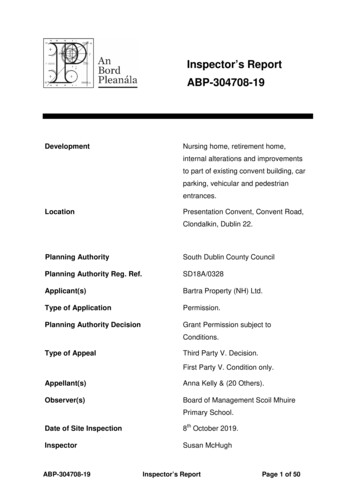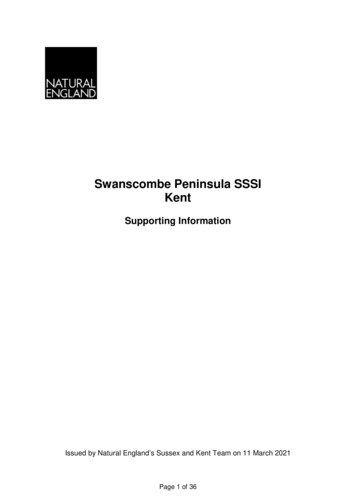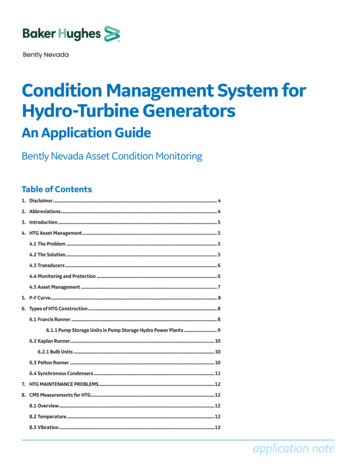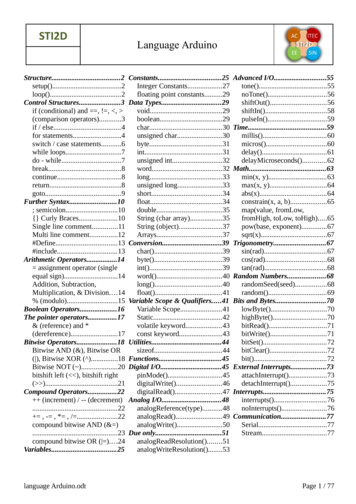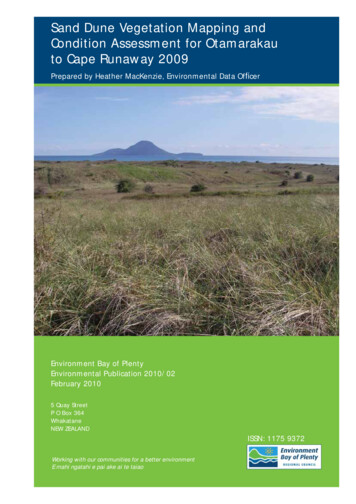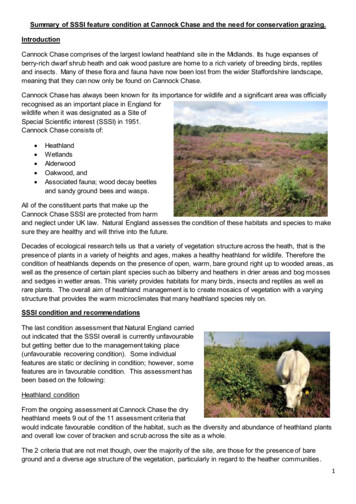
Transcription
Summary of SSSI feature condition at Cannock Chase and the need for conservation grazing.IntroductionCannock Chase comprises of the largest lowland heathland site in the Midlands. Its huge expanses ofberry-rich dwarf shrub heath and oak wood pasture are home to a rich variety of breeding birds, reptilesand insects. Many of these flora and fauna have now been lost from the wider Staffordshire landscape,meaning that they can now only be found on Cannock Chase.Cannock Chase has always been known for its importance for wildlife and a significant area was officiallyrecognised as an important place in England forwildlife when it was designated as a Site ofSpecial Scientific interest (SSSI) in 1951.Cannock Chase consists of: HeathlandWetlandsAlderwoodOakwood, andAssociated fauna; wood decay beetlesand sandy ground bees and wasps.All of the constituent parts that make up theCannock Chase SSSI are protected from harmand neglect under UK law. Natural England assesses the condition of these habitats and species to makesure they are healthy and will thrive into the future.Decades of ecological research tells us that a variety of vegetation structure across the heath, that is thepresence of plants in a variety of heights and ages, makes a healthy heathland for wildlife. Therefore thecondition of heathlands depends on the presence of open, warm, bare ground right up to wooded areas, aswell as the presence of certain plant species such as bilberry and heathers in drier areas and bog mossesand sedges in wetter areas. This variety provides habitats for many birds, insects and reptiles as well asrare plants. The overall aim of heathland management is to create mosaics of vegetation with a varyingstructure that provides the warm microclimates that many heathland species rely on.SSSI condition and recommendationsThe last condition assessment that Natural England carriedout indicated that the SSSI overall is currently unfavourablebut getting better due to the management taking place(unfavourable recovering condition). Some individualfeatures are static or declining in condition; however, somefeatures are in favourable condition. This assessment hasbeen based on the following:Heathland conditionFrom the ongoing assessment at Cannock Chase the dryheathland meets 9 out of the 11 assessment criteria thatwould indicate favourable condition of the habitat, such as the diversity and abundance of heathland plantsand overall low cover of bracken and scrub across the site as a whole.The 2 criteria that are not met though, over the majority of the site, are those for the presence of bareground and a diverse age structure of the vegetation, particularly in regard to the heather communities.1
Bare ground is vitally important for the rare ground-nesting birds such as nightjar, and special heathlandbees and beetles such as tawny mining bee and green tiger beetle, as well as providing new seeding areasfor heathland plants. A diverse age structure is also vital as it means that the heathland is regeneratingand there is a variation in structure within the heather shrubs as they age. It is worth noting that differentwildlife use heather plants in different stages of its growth cycle.Heathland recommendationsWe advise that future site management includes measures to create bare ground and create a wider rangeof heather ages through a variety of measures such as a more varied cutting regime, turf removal, scrapingand grazing. The presence of important historic features ought not tobe an obstacle to turf removal and scraping work; their locations areknown, thanks to intensive survey work over the last 10 years, whichcontinues to be developed with the County Archaeologist and HistoricEngland to ensure the nationally important historic features at CannockChase continue to be conserved and enhanced.In addition to actively creating bare ground, the introduction ofconservation grazing with cattle would also help create small areas ofbeneficial bare ground as well as help keep newly created bare groundareas open for longer through their grazing and browsing behaviour.Cattle used for conservation grazing can venture where machines andhumans cannot easily access, such as the steep ground at CannockChase where there is a lot of deep bracken and old heather. Theirgrazing, browsing, walking and lying-up activities can create small scale positive changes in the microstructure of the heathland vegetation over time that would be difficult, if not impossible to create using handtools and machinery.Wetland conditionLowland heathlands often contain wetlands such as streams and valley bogs, which when compared tothose in the wider countryside have not been drastically altered, and so still contain rare habitats andspecies. The surrounding heathland protects the wetlands as it ensures that water entering the wetland isclean and flows naturally into the wetland system. Where wetlands have been altered on lowlandheathland sites and there is a negative impact on the surviving vegetation there are huge opportunities toachieve full restoration of a naturally-functioning ecosystem that will benefit flora and fauna and make thehabitat as robust as possible to cope with the changing climate.Many such restoration projects have been completed and are underway on other sites such as the NewForest and the Forest of Dean.The majority of the wetland vegetation at Cannock Chase can be found in the Oldacre and Sher BrookValleys. Unfortunately the wet heathland-valley mire wetland mosaics in both valleys are in unfavourablecondition because they do not meet the majority of the assessment criteria.We believe this is principally due to changes in hydrology, which has led to impoverishment of thevegetation but also a lack of conservation grazing to manage the wetland vegetation that continues tosurvive there. In the Sherbrook Valley there is much less water in the system than was historically thecase, although when and why this has occurred is still unclear despite much investigation. In the Oldacrevalley the situation is hopefully clearer with the changes in hydrology likely linked to the WW1 campdrainage/sewerage system; the investigation and restoration of which would provide great opportunities forunderstanding and conserving this unique historic feature in-situ while minimising its hydrologicalfunctioning.2
Wetland recommendationsAt Cannock Chase conservation grazing would have a beneficial impact on the wetland vegetation of theOldacre and Sherbrook Valleys by reducing the dominance of taller, competitive plants such as purplemoor-grass and rush species and so allowing the smaller, more delicate plants, such as sundews andsedges to thrive. It could also restrict the amount of scrub that would otherwise develop in these streambasins.There are also rare fauna that live in the wetlands feeding off plants within them, such as the small pearlbordered fritillary butterfly and bog bush cricket. Cannock Chase is a county stronghold for these species.Grazing would help keep the wetland habitats open so that the butterfly’s food-plant, marsh violet, canthrive and in turn so can the butterfly. Bog bush cricket live in dense purple-moor grass areas and therecould be an impact on the vegetation cover of these areas if the area was overgrazed. Therefore anappropriate grazing regime would be required for these areas. The impacts of grazing would be monitoredand management adapted to avoid adverse impacts on the bog bush cricket populations. StaffordshireCounty Council and Butterfly Conservation continue to monitor such rare invertebrate species atappropriate intervals and further survey would be done before introduction of grazing at Cannock Chase.Indeed, a detailed grazing and monitoring strategy would be required as part of any future grazing regimeto avoid adverse impacts on all rare species at Cannock Chase.Alderwood conditionsAt Cannock Chase the wet alder woodland mainly grows throughout the Sherbrook Valley with a smallerarea at Penkridge Bank. The alder woodland meets 7 out the 9 assessment criteria that would indicatefavourable condition of the habitat. Again, changes in hydrology due to the presence of drains in parts ofthe woodland in the Sherbrook Valley is thought to be affecting the composition of the woodland groundflora.Alderwood recommendationsEncouraging natural processes of collapse and regeneration, along with ensuring a natural, clean watersupply will help the alderwood restore itself over time to a structurally-diverse wet woodland ecosystem thatprovides habitats for many birds and insects.Marsh violet is the larval foodplant of the small pearl-bordered fritillary and grows throughout the alderwoods of the central Sherbrook Valley. Coppicing of certain alders around where the marsh violet growswill allow more light into these areas as well as keeping the butterfly population connected through thelandscape. Conservation grazing cows would benefit the butterflies by helping to keep areas of marsh violetopen through browsing and generally moving through the alderwood.The alderwood around the lower reaches of the Sher Brook is even-aged and to encourage a more diversestructure, specific areas could be managed by coppicing to create areas of new growth. Removing theinfluence of any drainage structures by interval blocking, preferably filling in the entire ditch network, is alsoa key management recommendation for the alderwood here. This may however, also require furtherconsultation with the County’s principal Archaeologist where WW1 features are involved.Oakwood conditionsThe main area of oak woodland at Cannock Chase is at Brocton Coppice: an excellent example of a heathyoak-birch wood-pasture. That is, a stand of open grown veteran trees in an informal setting. There arestands of younger birch and oak trees amongst the old veterans, giving aspects of the site a feel of aclosed-canopy woodland, but the main interest of Brocton is the veterans, and their past managementsince 1500 as grazed wood pasture which allowed them to flourish as open-grown trees. The beetle fauna3
living in the veteran trees here is of special interest for the presence of a group of wood decay speciesindicative of ancient woodland sites with a continuity of old timber trees.Ongoing monitoring of the veteran trees shows that the wood decay invertebrates are in favourablecondition and that Brocton Coppice is of national importance for its saproxylic (wood decay) assemblage ofinvertebrates. It is home to 27 wood decay beetles that currently have a conservation s tatus.The wood pasture vegetation itself meets the majority of the criteria for favourable condition apart from therequirement for the presence of saplings and young trees which are the next generation of veterans. Thisis likely due to a number of factors such as lack of light reaching the woodland floor, but more likely highgrazing pressure by deer.Oakwood recommendationsManagement for wood decay invertebrates focuses on ensuring a continual supply of wood decay resourcesuch as decay in living trees, standing decaying wood and fallen decaying wood on the woodland floor.The most valuable wood decay resource is found on living trees due to the stability and variety of thedecay. Ensuring that the existing veteran trees live for as long as possible is the key conservationmanagement aim for the oak wood pasture at Cannock Chase. As the veterans age to become ancientsthey continue to support the nationally important fauna and also develop more types of wood decay whichwill support even more biodiversity. To ensure this longevity, veterans need to be able to grow outwards.Where veterans are currently being crowded and shaded by young woodland growth, often birch, thisneeds to be gradually removed over several years to allow the veterans to adapt to the increasing light andwarmth levels and decreasing humidity. Due to the way that they graze, conservation cattle would helpmaintain the restored openness around the veterans as well as creating mosaics of structure andregeneration patches in the wider wood pasture vegetation so improving the diversity in the ground floraover time.In addition to managing the existing veteran tree resource, the other key aim of managing wood pasture isto ensure the next generation of veteran trees is identified and managed for nature conservation. Thisincludes selecting trees to pollard or coppice as well as new plantings, using acorns from the existing treesin the Coppice. Understanding the reasons for the current lack of regeneration is vital for the health of thewood pasture, however. Providing the reasons for the lack of current regeneration are addressed,conservation cattle grazing would help the regeneration of trees by creating mosaics of shorter, light-filledpatches through the wood pasture vegetation so that acorns can root and receive sufficient light to grow.Consequences of not using conservation grazing at Cannock Chase SSSI and evidence for theeffectiveness of conservation grazingWithout conservation grazing we believe that it will be impossible for the wetland valleys to ever achievefavourable condition and highly unlikely that the dry heathland or wood pasture will achieve favourablecondition. Grazing could be replicated using small machinery and/or using hand tools if money, includingstaff resources, was unlimited but this is unrealistic and also unsustainable. Realistically, and in the face offuture uncertainties about funding for conservation land management, once established and supported,conservation grazing is the most sustainable management over the long term.In relation to the presence of the bilberry disease Phytophthora pseudosyringae across many parts ofCannock Chase, Natural England believes that the consequences of not grazing the habitats at CannockChase, as detailed above, are greater than the increased risk of spreading the disease across the site.In addition to the challenges of usual heathland management, there is also the challenge of future-proofingour heaths in the face of climate change and air pollution, both of which are affecting Cannock Chase now.For plants and animals to cope with the changing climate the habitats they rely on need to be in theirbest/most ecologically-robust condition.4
Heathlands are a nutrient-poor environment and the plants and animals that live there are adapted to livingin it. Air pollution contains nutrients such as ammonia that drives changes in the vegetation by fertilising theheathland so that species that can exploit more nutrients such as grasses, quickly start to dominate overless competitive plants such as wildflowers and bog mosses. Conservation grazing animals would help toremove nutrients from the heathland by grazing vegetation and although they also add nutrients back to theheath, the system is a closed circle.Conservation grazing is not a ‘quick fix’ and its effects would not be immediately apparent. Realistically itcould take several years to perfect the grazing regime. Also, other management practices would still beneeded such as bracken and scrub control and bare ground creation, but over time, as the effects ofgrazing become apparent through monitoring, bracken and scrub control might be needed less. There isevidence from other sites that cattle grazing can help to restore steep, dense bracken slopes to a heathyvegetation over time through a combination of trampling, lying up in it, breaking up the dead bracken litterand spreading heather seeds into it from their coats, as well as browsing grasses within the bracken hereand there, although they do not preferentially eat bracken.Best Practice from other areas using conservation grazingMany lowland heaths in the UK and Europe are managed by conservation grazing animals. Some localexamples are the Connecting Cannock Chase heathland corridors between Gospel End and BrindleyHeath created by the Forestry Commission, Hednesford Hills Local Nature Reserve, Chasewater CountryPark, Sutton Park National Nature Reserve, and Barlaston Common. In the wider West Midlandsconservation grazing is used to manage heathland sites such as Wetley Moor, The Roaches, Kinver Edge,Brown Moss, Stiperstones National Nature Reserve, Devil’s Spittleful, Hartlebury Common and PoundGreen, part of the Wyre Forest National Nature Reserve in Worcestershire managed by Natural Englandand the Forestry Commission. There are many otherprotected sites with similar habitats to Cannock Chaseacross the country, such as the Ashdown Forest wherecattle grazing is used as a key management tool tomove sites into favourable condition.We advise that a conservation herd of cattle is used tograze Cannock Chase SSSI. Ideally, there would be acombination of animals such as cattle, sheep andponies, which all graze in different ways so incombination would produce an even more diversestructure to the heathland vegetation. Given the highlevel of use by the public for various activities however,the most appropriate animal that would deliver the best grazing is cattle. Conservation cattle grazing onheathland is not the same as cattle grazing in a pasture on a farm. Stocking levels need to be much lowerthan on farmland, about 15% of the level grazed on lowland farmland, and over much larger areas.Cattle grazing is used on numerous nature conservation sites across the country with the aim of restoringhabitats to a good condition so that they are beneficial to wildlife. Many of these sites are accessible to thepublic; indeed public access is encouraged.We advised the Council to include as much of Cannock Chase SSSI as possible within the grazingconsultation to achieve the maximum benefit from a new conservation grazing regime; this should includeboth the wetland valleys, Oldacre and the Sher Brook, as well as the ancient wood pasture at BroctonCoppice.5
Knowledge of how best to manage habitats comes from years of ecological research and experience fromacross the UK and in Europe where sites face the same management issues. The following details someof this research to show how grazing can be beneficial to heathland species.Species diversity including rare and endangered species, and vegetation structureOver the last 60 years a wealth of research has been carried out into the ecology and modern managementof lowland heathlands. This section outlines some of the more recent research into the benefits of grazingas an effective conservation management tool.Bokdam & Gleichman (2000), looked at six different heathland types in the Netherlands with differentnutrient loads. During the first 5 years, grazing induced a significant increase in species richness in allhabitats, which stabilised during the second 5 years in most cases. They conclude that “Free-ranginggrazing combined with tree cutting appeared to be a suitable management regime for the maintenance ofspecies-rich open heathlands with dynamic grass-heather mosaics”.Buttenschøn & Buttenschøn (2015), studying five sites in Denmark which had been grazed between 15 and40 years, recommend that grazing is used in heaths in favourable condition, while it needs to be combinedwith mowing in restoration sites. They found that a pressure of 0.35-0.6 LU/ha/yr reduced cover of oldheather and increased young stages; species diversity doubled to quadrupled (including rare andcharacteristic species); the amount of coarse and dead vegetation decreased, gaps appeared and lichensand mosses increased cover from 10 to 50%. (LU livestock unit. 1 LU is the same as 1 adult cow). Whenthe grazing pressure decreased grasses and trees invaded. In a second site grazing reduced litter heightcompared with controls (i.e. no management). They found that cattle selectively eat some grass species,which have high nutritive value before flowering, in spring and summer, whereas they ate dwarf shrubs inAugust-September.Fagúndez (2016) Showed that grazing, mostly by wild ponies in northern Spain, was positively related toplant diversity and vegetation structure. Lack of grazing or high cattle densities resulted in a negative effecton total and rare species richness and diversity.Groome & Shaw (2015) report on the results of a nine year study of the effects of restoring low-intensitycattle grazing on the post-fire recovery of vegetation on the lowland valley mire and wet heath of Folly Bog,Surrey. Four distinct vegetation communities were studied, inside and outside grazing exclosures. Speciesrichness increased across the valley mire, largely as a result of grazing-induced decreases in purple moorgrass and vegetative litter and increases in bare ground. Uncompetitive liverworts and waterlogging tolerantgraminoids were particularly favoured. Purple moor-grass and litter removal also encouraged the spread ofbog-mosses Sphagnum spp., although trampling in the wettest vegetation resulted in locally severedamage to the moss layer. On the firmer substrates of the wet heath, there were no such deleterioustrampling impacts. Here, both bog-moss cover and species richness increased significantly, largely due tosuppression of shade-producing heather and litter, and the maintenance of bare ground. Their resultsreveal that the resumption of low intensity cattle grazing had many positive conservation benefits , althoughother forms of management to supplement grazing will most likely continue to be required.Piessens et al (2006) found that overall, heathland vegetation in a Belgium site changed little during thestudy period and the proposed management seemed to have succeeded in preserving the characteristicheathland vegetation and in retaining its typical nutrient-poor, acid character. Their results indicate that anextensive grazing management, as commonly applied in many nature reserves, is able to conserve speciesdiversity in heathlands subject to high levels of nitrogen deposition and acidificationRupprecht et al (2016) report how year-round grazing by cattle and horses has recently become a commonpractice in conservation management in north-western Europe. However, there are no comprehensiveregional surveys allowing the detection of general patterns beyond single case studies. This applies even6
more to nutrient-poor sites where year-round grazing systems were only recently established and concernsabout potentially negative effects on plant diversity are still prevalent. Their study investigated the impactsof year-round grazing on plant species richness, species composition, and vegetation structure on nutrientpoor sites using a regional multi-site approach. Surveys were carried out at five different study sites in thediluvial plain of northwestern Germany and the Netherlands comprising sand grasslands, dry grasslands,and heathlands. Results showed overall positive effects of grazing: Plant species richness, the number ofendangered plant species, and the proportion of open soil were increased significantly. Contrary, greenbiomass, litter cover, vegetation height, and the cover of woody species significantly decreased. At grazedsites there were more small, light-demanding species than taller, mesophilic species. A distinct decrease ofruderal species and an increase of species following a competitive strategy was observed at abandonedsites. Based on broad regional evidence, they concluded that year-round grazing is a suitable tool for therestoration and management of open habitats on nutrient-poor sandy sites. Low sward biomass and poornutritional quality raise, however, concerns about adequate fodder supply and animal welfare.WallisDeVries et al (2016) pointed out that grazing at low stocking rates is often recommended for thepreservation of the characteristic biodiversity of open landscapes. However, the fine-tuning of grazingmanagement still lacks a good evidence base. This is particularly true for insect communities, as availableevidence indicates that these are more vulnerable to grazing than plant communities. The outcome,however, may be expected to differ between insect species. They analysed the impact of different grazingintensities on insect communities from lowland heathlands in the Netherlands. They found that speciesfrom early successional stages benefit from grazing whereas late-successional species would suffer fromgrazing. Moreover, they found summer grazing to have less beneficial effects than year-round grazing.Species responses to grazing contrasted between early and late successional species. Variation in speciesresponses were strongly linked to grazing intensity and soil moisture, reflecting species -specific niches inrelation to vegetation structure and microclimate. They concluded that low-intensity year-round cattlegrazing or herded sheep grazing may promote insect biodiversity in large, heterogeneous heathlands,whereas targeted or rotational grazing may be advisable in smaller areas.Cox (2005) described a botanical plot that was established in May 1995 at West Bog within Hartland MoorNNR, Dorset, in order to monitor the effects of the reintroduction in summer 1995 of grazing by hardyponies and cattle on the vegetation. Measurements of vegetation height and cover of bare ground andstanding water were recorded, and photographic monitoring was also carried out. The monitoring wasrepeated every three years, in May 1998, 2001 and 2004, and the data analysed. The results wereencouraging, showing an increase in species diversity, a decrease in vegetation height and rank growth ofpurple moor grass and straggling heathers, an increase in openness of the vegetation, and an increase inplants of conservation value, including sundews, bog asphodel and bog mosses. Some reduction of grazinglevels within the plot was observed between 2001 and 2004.Lake et al (2001) concluded in this review is that grazing by livestock is an appropriate management forlowland heathland in terms of delivery of conservation objectives.Rare plantsByfield and Pearman (1996) linked declines in rare plant species in heathlands with the cessation ofgrazing.Chapman et al (1989) and Oostermeijer (1994) found that vegetation structure, particularly the amount ofbare ground and cover of the litter layer, determine the age structure of the Marsh gentian population whichis in turn related to its long term health. Grazing is one method by which such favourable vegetationcharacteristics can be maintained.Invertebrates7
Thompson et al (2004) identified changes in grazing regimes i.e. less grazing as one of the main factorsresponsible for declines of damselfly populations. Grazing is recommended as a key part of goodmanagement.In Dorset there was a large expansion in the range of southern damselfly following the start of a grazingregime on Hartland Moor in 1994.Heathland birdsSitters et al (1996) report that the long-term decline of Woodlarks on Breckland heaths can probably belargely attributed to reduction in grazing, both by stock and rabbits. Grazing is certainly the desirable meansof creating and maintaining Woodlark habitat on much heathland.Sharps et al (2015) looked at habitat selection by Nightjar within a plantation-forest landscape. Openungrazed habitat was not selected.ReferencesBokdam J. & Gleichman J.M. 2000. Effects of grazing by free-ranging cattle on vegetation dynamics in acontinental north-west European heathland. Journal of Applied Ecology, 37, 415-431.Buttenschøn, R.M. & Buttenschøn, J. 2015. [in Danish originally]. Long-term effect of cattle grazing onheathland vegetation. Flora and Fauna, 121(3):95-104.Byfield A. & Pearman D .1996 Dorset's disappearing flora. Changes in the distribution of Dorset's rarerheathland species 1931 to 1993. Plantlife, RSPB.Cox. J 2005 Botanical monitoring of the Dorset heathlands wildlife enhancement scheme – West Bog,Hartland Moor NNR. Internal English Nature report.Chapman SB, Rose RJ, and Clarke RT 1989 The behaviour of populations of the marsh gentian (Gentianapneumonanthe L.): a modelling approach. Journal of Applied Ecology, 26, 1059-1072.Groome G.M. & Shaw P. 2015. Vegetation response to the reintroduction of cattle grazing on an Englishlowland valley mire and wet heath. Conservation Evidence, 12, 33-39.Lake, S., Bullock, J.M., & Hartley, S. 2001. Impacts of livestock grazing on lowland heathland in the UK.English Nature Research Reports, No. 422.Oostermeijer JGB, Van’t Veer R, Den Nijs JCM 1994. Population structure of the rare, long-lived perennialGentiana pneumonanthe in relation to vegetation and management in the Netherlands. Journal of AppliedEcology 31, 428-438Piessens, K., Aerts, N. & Hermy, M. 2006. Long-term (1978-2003) effects of an extensive grazing regimeon plant species composition of a heathland reserve. Belg. J. Bot. 139 (1): 49-64.Rupprecht, D., Gilhaus, K., Hölzel, N., Effects of year-round grazing on the vegetation of nutrient-poorgrass- and heathlands—Evidence from a large-scale survey. Agric., Ecosyst. Environ. (2016)Sitters HP, Fuller RJ, Hoblyn RA , Wright MT, Cowie N &. Bowden CGR 1996. The Woodlark Lullulaarborea in Britain: population trends, distribution and habitat occupancy, Bird Study, 43:2, 172-187Sharps K, Henderson I, Conway G, Armour-Chelu N, Doman PM 2015. Home-range size and habitat useof European nightjars Caprimulgus europeaus nesting in a complex plantation-forest landscape. Ibis 157,260-272.Thompson DJ, Rouquette JR, Purse BV (2004) Ecology of the Southern8
Damselfly, Coenagrion mercuriale. Conserving Nature 2000. Rivers Ecology Series no. 8. English Nature,Peterborough.WallisDeVries MF, Noordijk J, Colijn EO, Smit JT, Veling K. 2016. Contrasting responses of insectcommunities to grazing intensity in lowland heathlands. Agriculture, Ecosystems & Environment, In Press,9
Summary of SSSI feature condition at Cannock Chase and the need for conservation grazing. Introduction Cannock Chase comprises of the largest lowland heathland site in the Midlands. Its huge expanses of berry-rich dwarf shrub heath and oak wood pasture are home to a rich variety of breeding birds, reptiles and insects.
